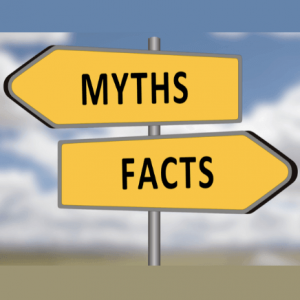Experts Bust 6 Common Myths About Celiac Disease
 A search on Instagram with the hashtag #glutenfree yields over 41 million posts. Between holistic healers peddling untested remedies and pseudoscience around the effects of gluten, it can be hard to sift through the noise.
A search on Instagram with the hashtag #glutenfree yields over 41 million posts. Between holistic healers peddling untested remedies and pseudoscience around the effects of gluten, it can be hard to sift through the noise.
- Nicole Karlis, salon.com 1
According to Dr. Peter Green, Director of the Celiac Disease Center at Columbia University, celiac disease has increased fivefold over the past 50 years, with the majority of that occurring in the 1990s.
A meta-analysis study published in the American Journal of Gastroenterology in 2020 supports this claim, finding that celiac disease has been on the rise throughout the Western world, with higher incidence rates in females and children.
Increased awareness about celiac disease coupled with internet access may be contributing to an increase in numbers of people adopting a gluten-free diet as a lifestyle choice.
The reason for this increase in celiac disease continues to vex scientists. The medical and scientific community have been actively researching the possible reasons for this dramatic rise in autoimmune issues with ingesting wheat.
Lack of research funding contributes to long-standing misinformation about celiac disease.
- “We don’t know why it increased,” Green said. “But there is evidence that it’s leveling off,” he said, pointing to some research from Finland.
However, with so many unknowns surrounding celiac disease — like how many people have it, and what’s causing the rise — misinformation follows.
1. Despite a common misconception, celiac disease isn’t a gastrointestinal disease, but an autoimmune one. People who have celiac disease have developed an immune reaction to gluten, which is a protein found in wheat, rye, barley and triticale.
2. Green said it is not a “typical” allergy, so to speak, because the response can be delayed.
3. “There’s actually less gluten ingested by the public now than 100 years ago.”
“There’s actually less gluten ingested by the public now than 100 years ago,” Green said. “Celiac disease has increased, and we don’t know why, but autoimmune diseases and allergies have also increased and we don’t know why.”
An oft-seen, unfounded rumour as to the cause of celiac disease has to do with industrial manipulation of grains.
4. “One of the common myths out there is ‘we have genetically modified wheat,'” Dr. Amy Burkhart, a physician and registered dietitian, told Salon. “But there is no genetically modified wheat in the U.S.”
Yet some patients insist something is different about American wheat. Both doctors said they’ve heard from patients with gluten sensitivities who reported that they have visited another country — say in Europe where food safety standards are more stringent — where they ate food with gluten didn’t have symptoms.
“I’ve heard this, and it’s a really interesting kind of phenomenon, but it’s important to say that this is people with gluten sensitivity — not with celiac disease. People with celiac disease should never go to Europe assuming that they can eat the gluten foods,” Burkhart said.
She noted that that those with a gluten sensitivity have a spectrum of gluten they can tolerate.
“People think maybe because the gluten content of wheat in Europe is lower — maybe it’s because the growing conditions are different and the climate that the wheat is grown in can affect how much gluten is in that food.”
5. Burkhart said there are more additives in food in America than in Europe, which could be part of the phenomenon. Green said he suspects that high-fructose corn syrup could be part of why people with gluten sensitivities feel better eating abroad.
“I have many patients who go to Europe and say ‘my stomach feels right,’ but we don’t know what that’s due to,” Green said. “Food is different in the United States, but part of that is always high fructose corn syrup that people add to food in the United States, as a replacement for sugar.”
But Green emphasized that wheat in America is almost certainly not the cause of the rise of celiac disease.
6. He pointed to the fact that celiac disease is rising in countries like Australia and Canada, too. He said that theories that suggest grain has been altered or that gluten has changed over the last hundred years aren’t true either.
Celiac disease “has not received a large amount of research” monies, Green said. “It has been under-investigated.”
Burkhart said she does believe that an increase in public awareness of celiac disease has understandably played a role in the rise of celiac disease, in addition to an increase in testing and the rise of the internet as a forum for medical discussion.
“People talk, information is shared, and symptoms are discussed; this quickly spreads awareness of information, including information regarding celiac disease,” Burkhart said.
“Patients began asking for testing and recommending it to friends; some of these patients, of course, have been diagnosed with celiac disease and they might not have otherwise thought of celiac disease or asked for testing if they hadn’t read about someone with similar symptoms.”
Despite the mystery surrounding celiac disease, Green said researchers struggle with a lack of funding that might help them get answers.
Celiac disease “has not received a large amount of research” monies, Green said. “It has been under-investigated… there are only a few individuals actually, all around the world who have demonstrated the mechanism of celiac disease.”
Hence, a few researchers are doing a lot of the legwork, Green said. “We understand how the gluten fragment interacts with the immune system and results in inflammation in the intestine… we have a very great amount of knowledge now, and that’s been developed by just a few people.”
Green said that “failure of physicians” to think about the diagnosis, and a lack of knowledge of the testing and how a diagnosis should be made, is the primary cause of people not being diagnosed.
“We often hear stories, people say, ‘I’ve been going to a doctor for a long time and then the doctor had a new person come into the practice and a new person diagnosed me,’ or ‘I’ve been seeing doctors and then I had to go to the emergency room for some reason and the doctor in the emergency room diagnosed by celiac disease,'” Green said.
“There’s a period of time in which an individual tolerates gluten and then for some reason, they develop this immune reaction which causes inflammation, the development of the antibodies, the inflammation in the intestine which causes atrophy,” Green said.
Notably, doctors say many people with celiac disease aren’t diagnosed properly. One issue is that physicians often don’t think about the diagnosis, partly because symptoms can vary.
Indeed they include bloating, chronic diarrhea, constipation, gas, lactose intolerance, nausea, vomiting, or pain in the abdomen. A flare-up can physically manifest itself as an itchy rash on a person’s skin that can appear as clusters of bumps or blisters.













